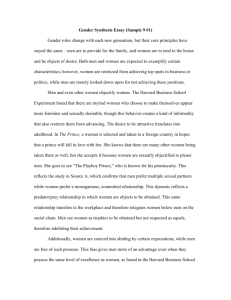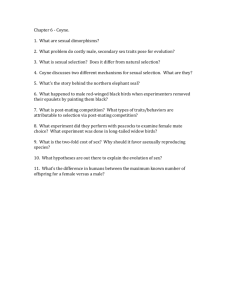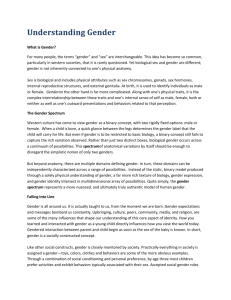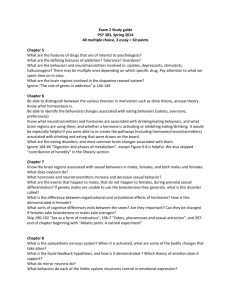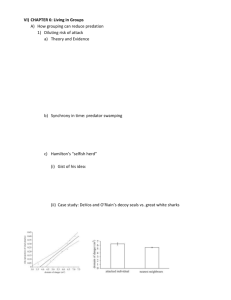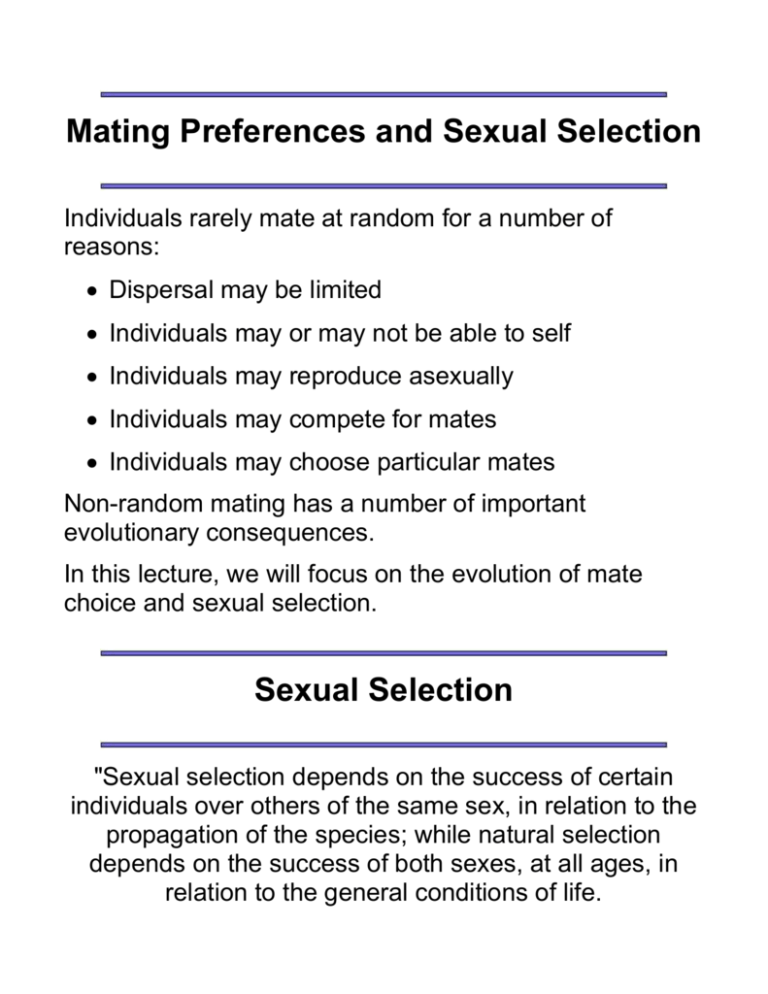
Mating Preferences and Sexual Selection
Individuals rarely mate at random for a number of
reasons:
Dispersal may be limited
Individuals may or may not be able to self
Individuals may reproduce asexually
Individuals may compete for mates
Individuals may choose particular mates
Non-random mating has a number of important
evolutionary consequences.
In this lecture, we will focus on the evolution of mate
choice and sexual selection.
Sexual Selection
"Sexual selection depends on the success of certain
individuals over others of the same sex, in relation to the
propagation of the species; while natural selection
depends on the success of both sexes, at all ages, in
relation to the general conditions of life.
The sexual struggle is of two kinds: in the one it is
between the individuals of the same sex, generally the
males, in order to drive away or kill their rivals, the
females remaining passive; while in the other, the
struggle is likewise between the individuals of the same
sex, in order to excite or charm those of the opposite sex,
generally the females, which no longer remain passive,
but select the more agreeable partners."
Darwin (1871)
The Descent of Man and Selection in Relation to Sex (p.
639)
Sexual Selection: Classification
Following Darwin, two main forms of sexual selection are
recognized:
(1) Intrasexual selection (competition within a sex for
the opportunity to mate)
(2) Intersexual selection (choosiness on the part of one
sex for mates)
Although female-female competition and male
choosiness are known, we'll focus on the more common
patterns of male-male competition and female choice.
Why might these be the more common patterns?
(1) Intrasexual selection (male-male
competition)
Horns, antlers, tusks, spurs
and other weapons provide
some of the most extreme
examples of sexual
dimorphism.
Possible explanations:
(1) Weapons against predators
(2) Weapons against other males
(3) Indicators of male strength and fighting ability
(male-male competition)
(4) Indicators of sexual vigor and quality (female
choice)
Examples:
Barrette and Vandal (1990) studied sparring in caribou.
Of 713 matches between males of different antler size,
males with smaller antlers withdrew 90% of the time.
Eberhard (1979,1980) studied the use of horns in
seventeen species of beetles, finding that they tend to be
used either to pry a rival off his site or to lift and drop the
rival to the ground.
Brown and Bartalon (1985) placed forked fungus beetles
together in a terrarium. Males with the longest horns had
higher access to females. Female preference was not
observed.
"Among the explanations for sexually dimorphic
horns, antlers, tusks, and spurs, the empirical
support is strongest for the idea that they have
evolved and are favored in males as weapons in
contests over females."
Andersson (1994) Sexual Selection (p. 314)
(2) Intersexual selection
Some of the more profoundly beautiful traits seen in
nature have evolved in response to female choice.
Theories for the existence of female preferences &
exaggerated male secondary sexual traits:
1. Female choice and male traits co-evolve (Fisher's
Runaway Process)
2. Choosy females gain benefits from their mates.
These can be
Direct benefits
Genetic benefits
3. Female are choosy because of a sensory bias
Fisher's Runaway Process
PHASE 1: Female preferences initially evolve because
they favor a trait in males that is also favored by natural
selection. The offspring of choosy females are then more
likely to carry the advantageous trait.
"Whenever appreciable differences exist in a species...,
there will be a tendency to select also those individuals of
the opposite sex which most clearly discriminate the
difference to be observed, and which most decidedly prefer
the more advantageous type."
Fisher (1930)
PHASE 2: Once female preferences exist, they can favor
even more extreme traits in males. This can in turn favor
the evolution of stronger female preferences, leading to a
runaway process. Female preference and male trait
become genetically correlated.
"...the further development of the plumage character
will still proceed, by reason of the advantage gained
in sexual selection, even after it has passed the point
in development at which its advantage in Natural
Selection has ceased."
Fisher (1930)
The runaway process will halt when genetic variation is
exhausted or when the trait becomes so costly that
natural selection balances sexual selection.
Example:
In a breeding experiment with the threespine stickleback,
Bakker (1993) observed a genetic correlation between
red coloration among sons and preferences for red
coloration among daughters, as expected under the
Fisherian process.
When female choice is costly, the Fisherian model of
sexual selection will not work. Costs of choice can
include:
Time and energy for evaluating mates
Increased predation risk
Risk of remaining unmated
Example: Engelhardt et al (1982) found that choosy
female seaweed flies had reduced fertility.
Benefits to Choosiness
Female preferences may be beneficial. In this case,
natural selection will favor the evolution of preferences,
which in turn lead to the elaboration of the preferred trait
in males.
Possible benefits of being choosy:
Direct benefits:
Mate provides paternal care
Mate provides food (e.g. nuptial gift)
Mate has more sperm
Mate is less likely to pass diseases/parasites to
female
Lower risk of mating with the wrong species and
producing inferior hybrid offspring
Indirect benefits:
Offspring are more fit (Good genes hypothesis)
Examples of direct benefits:
Thornhill (1983) showed that female hangingflies lay
more eggs with males that provide larger nuptial food
gifts.
Pleszczynska (1978) showed
that male lark buntings with
more nest cover in their territory
attracted more females and
these females had higher
breeding success.
Examples of indirect benefits:
Male gray tree
frogs vary in the
duration of their
calls.
Females prefer to
mate with males
who give long
calls.
Males who gave
longer calls
produced offspring
who grew faster
and became
larger.
Call duration indicates genetic quality of males. Females
who mate with males who give long calls will have
offspring that are more fit. Hence, female preference for
long calls will be favored.
Sensory Bias
Female preferences may evolve as a correlated
response to the evolution of a favored male trait or due to
direct benefits of choosiness.
An alternative possibility is that female preferences are
simply a side-effect (a "pleiotropic" effect) of how sensory
systems have evolved.
Examples:
Searcy (1992) found that
female common grackles
preferred males singing an
artificial repertoire with four
song types even though males
in this species sing only one
song type.
Females have a bias for more
complex repertoires.
Basolo (1990) showed that female platyfish preferred
males with swords artificially attached, arguing that
evolution in the sister taxa (swordtails) was shaped by
this pre-existing bias for swords.
(On the left is a tropical green swordtail, on the right a southern
male platyfish with a sword artificially attached.)
Females may also prefer traits because they are easy to
see or hear. This favors conspicuous traits in males.
Mating Preferences and Sexual Selection
Regardless of how mating preferences have evolved,
their presence in a population has profound influences on
the evolution of morphology, behavior, and
communication.
Sexual selection has undoubtedly contributed to the
evolution of some of the more spectacular traits seen in
the natural world (e.g. the radiant feathers of peacocks,
the flashing lights of fireflies, the nightly song of crickets).
In addition, sexual selection can lead to rapid
reproductive isolation of populations, thereby contributing
to speciation.
For example, sexual selection has played a crucial role in
the explosive radiation of Drosophila species on Hawaii
(800-900 species) and of cichlids in the African Rift
Lakes.
SOURCES:
Malte Andersson's (1994) book entitled Sexual Selection
is a fantastic source of information about the theoretical
and empirical support for various hypotheses about mate
choice. Most of the examples used in this lecture are
drawn from his book.
Additional pictures come from Sexual Selection (1989) by
Gould and Gould and from your textbook.

